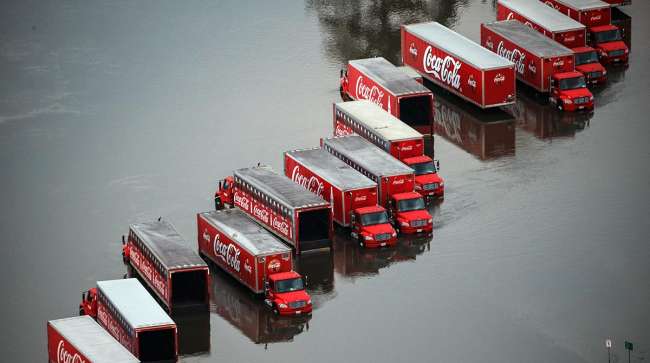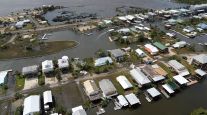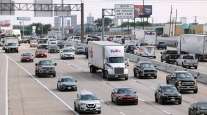Trucks, Planes and Tankers Putting Houston Back in Business After Hurricane Harvey

Houston’s roads, skies and waterways saw increased traffic Sept. 5 as some of the city’s biggest industries continued a slow march toward business as usual.
United and Southwest airlines operated more robust schedules, oil tankers headed toward the shoreline and ship movements returned to nearly normal levels at the Port of Houston.
“Things are getting back to normal,” said Capt. Mike Cunningham, director of program management at the Greater Houston Port Bureau. “There are more and more vessel transits every day.”
Trucking
Tropical Storm Harvey is being blamed for a price spike to have certain trucks carry goods into the Houston region, said Noël Perry, partner and transportation economist at FTR Transportation Intelligence.
The inbound rate for flatbed trucks, used to haul construction materials and the like, increased 4% for the period just before and during the storm. Rates then increased 24% in the past seven days, Perry said.
The inbound rate for a standard truck carrying packaged goods increased 7% just before and early in the storm. The cost has increased 8% in the past seven days.
Both of those rate increases are for the spot market, where customers pay trucking companies for a one-time move as opposed to having a contract for frequent or recurrent moves.
Perry cited three main reasons for the inbound rate increases. First, truck drivers are entering the Houston region with full trucks but leaving with empty trucks since the industrial or manufacturing sectors are still behind in production. Also, people seeking construction materials or post-Harvey supplies quickly are willing to pay more.
A recent runup in diesel prices could also be contributing, and Perry said that impact may grow more noticeable.
“Since this price increase in fuel is so recent,” he said, “it’s probably not completely included in the price of transportation yet.”
AAA reported diesel prices in Houston averaged $2.44 on Sept. 5, up from $2.27 a week earlier and $2.15 a year ago.
RELATED: Diesel Soars 15.3 Cents to $2.758 a Gallon; Gas Up 28 Cents
TRUCKING IMPACT: 10% of U.S. trucking affected, FTR reports
TRUCKING STOCKS CLIMB: High demand expected for cleanup
John Esparza, president and CEO of the Texas Trucking Association, said the effects from higher-priced diesel are already being felt.
“A slight increase in gas will cause a significant increase in the amount it costs to move that product from point A to point B,” he said.
Perry predicted trucking rates will eventually settle down, but they probably won’t fall to previous levels. Trucking companies are shy about raising the prices, he said, but they’ll use events like this to modestly boost their margins.
Airports
United and Southwest both described their operations Sept. 4 as about 70% of a typical day.
United Airlines had more than 300 departures and roughly the same number of arrivals scheduled at Bush Intercontinental Airport on S. 5. It expects flights to operate at normal levels by Sept. 8.
Spokesman Charlie Hobart said its website and app are current. If these platforms say a flight will operate as scheduled, then United intends to operate it.
“Customers should feel confident about connecting through Houston,” Hobart said.
Overall, domestic flights at Bush Intercontinental were at 75% of typical operations, Houston Airport System spokesman Bill Begley said. Officials expect domestic and international flight service to be at 100% by the weekend.
Hobby Airport had 105 flights Sept. 5. A typical day has around 160 flights. Southwest said it plans to resume a full schedule at Hobby on Sept. 7.
Refineries
Some refineries are back to normal while others are slowly ramping up production after Harvey knocked out more than 20% of the nation’s fuel production at oil refineries, causing price spikes and some fuel shortages.
Refineries in Beaumont and Port Arthur could be the last to return to service, although some are beginning the methodical restart processes.
Motiva’s Port Arthur refinery, the nation’s largest, should be partially operational at the beginning of next week, Motiva Enterprises said Sept. 5. It hopes by Sept. 11 to have operations restored to 40% - churning out more fuel than many other refineries when fully in service.
San Antonio’s Valero Energy said it’s in the early stages of restarting its Port Arthur refinery. The other two major refineries in the area are further behind. Exxon Mobil said its Beaumont refinery is shut down because of floodwaters. Paris-based Total, which until recently had no power at its Port Arthur campus, hasn’t started work to restore its refinery there.
Meanwhile, the oil refining complex in Corpus Christi is nearly back to its pre-Harvey operations.
Flint Hills Resources confirmed Tuesday that its Corpus refinery is fully back online, just one day after Valero Energy said it had resumed its normal capacity to churn out gasoline and other fuels. Flint Hills is a subsidiary of Koch Industries.
The third major Corpus refinery, owned by Citgo Petroleum, is nearly back to normal operations.
In Baytown, Exxon Mobil said it is in the early stages of restarting the nation’s second-largest oil refinery.
Apart from its oil refineries, Exxon Mobil said its Houston fuel terminals are again supplying gasoline and diesel, and that it’s making “significant progress” in restarting its petrochemical, pipelines and logistical networks in the Houston area.
Oil tankers
Seaside commerce is also making a comeback, as healthy levels of oil tanker traffic returned to partially reopened ports.
From a satellite feed in Norway, Samir Madani, co-founder of TankerTrackers.com, counted around 275 vessels near major ports across the Gulf of Mexico, including 105 off the coast of the Houston and Galveston areas on Sept. 5.
The day before, those vessels delivered some 10 million barrels of oil into the Texas energy complex, on top of 4 million barrels imported over the weekend.
“It looks as if nothing happened from here,” said Madani.
On Aug. 26, Madani watched his monitor as nearly all of the 166 tankers off the Texas coast fled in the same direction at once, scurrying southeast into the depths of the Gulf of Mexico as Hurricane Harvey approached the Houston area.
When storms threaten the Gulf Coast, tankers usually take shelter near the coastline. But Hurricane Harvey was strong enough to wash out soil and run tankers aground. “It was like, danger, get out,” Madani said.
But on Tuesday, 33 tankers lined up in the Houston Ship Channel, two or three times more than usual.
Port of Houston
The Port of Houston, overall, had 47 deep-draft vessels enter or leave on Monday, approaching the port’s daily average of 51 transits, Cunningham said.
Port Houston, which operates the Bayport and Barbours Cut container terminals along the Ship Channel, reported 5,000 containers entering or leaving there on Sept. 8 and 3,000 on Sept. 4, Labor Day. Fourteen vessels called on the terminals between Sept. 1 and Sept. 4. That’s a lot of vessels over the four days as a typical week sees 17 vessels, a spokeswoman said, adding that the longshoremen and others worked Labor Day even though they generally have it off.
Certain portions of the Houston Ship Channel still have draft restrictions. Cunningham added that inland beyond the Loop 610 East bridge is mostly barge traffic, largely due to a sunken dry dock and other obstructions in the channel.
“Everybody is working really hard to get back to normal,” Cunningham said.
Distributed by Tribune Content Agency, LLC




